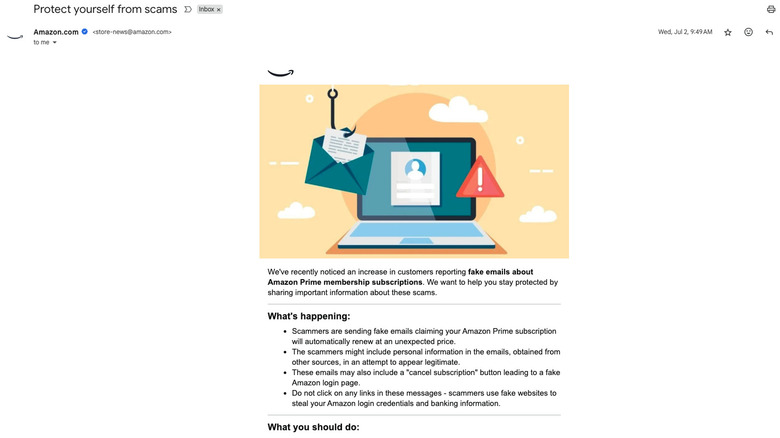Every Amazon Prime Member Should Be Aware Of This Email Scam Going Around
This summer's Prime Day event may be over, but scammers are still hard at work trying to trick Amazon Prime members into giving up their login credentials and payment details. Amazon recently sent out an email warning its more than 200 million Prime members to be on the lookout for realistic-looking phishing emails disguised as subscription renewal alerts. The scam arrives in your inbox in the form of a fake email that claims your Prime membership is about to renew, at a much higher price than you're currently paying. A "cancel subscription" button is often embedded in the email, prompting you to click or tap a link that takes you to a fake Amazon login page. If you enter your account details on the fake page, scammers might be able to gain access to your Amazon account, credit card information, and more.
If you're not familiar with the scam, the urgency of the email might be enough to get you to act quickly in an effort to avoid being charged. This scam is especially dangerous because of how convincing many of the emails look, with the scammers including personal information about you that they use to personalize the email and make you believe it's really from Amazon. While there are ways to determine if you're on a scam website, because these cybercriminals use what appears to be real Amazon branding, you may not realize anything is wrong until it's too late. Because of this, Amazon is advising users not to tap or click on suspicious links and to always access their accounts directly through its website or official app. If you're a Prime member, knowing how the scam works and how to avoid it could keep you from becoming a victim.
How to protect yourself from the Amazon Prime email scam
If a message lands in your inbox claiming your Amazon Prime membership fee is about to go up, you should view it with skepticism. The cybercriminals behind this scam have gone to great lengths to make their emails look like official Amazon renewal notices, and will frequently say your Prime membership is about to renew at a much higher rate. From fast shipping to streaming and exclusive deals, many perks come with an Amazon Prime subscription, which is exactly why scammers use the threat of a steep price hike to make you feel like you have to respond immediately. These messages may include buttons like "Cancel Subscription" or "Manage Membership" that link to a fake Amazon login page. If you enter your account credentials or payment info there, scammers can use that information to access your account, make unauthorized purchases, or steal your personal data.
There are several things you can do to protect yourself from this scam, starting with never tapping or clicking on a suspicious link. Instead of clicking or tapping buttons in an email, go directly to amazon.com or the Amazon app to manage your account. If you have questions about whether an email you've received is legitimate or not, check your Amazon Message Center. If the message isn't there, it's likely a scam. Official Amazon emails come from addresses ending in @amazon.com. If the sender or the link looks even slightly off, don't trust it. You should also enable two-step verification on your account to help prevent unauthorized access even if your password is compromised. If you have received a suspicious email, send it as an attachment toreportascam@amazon.com.

